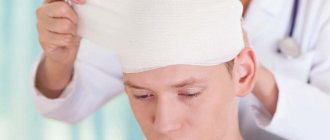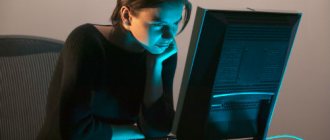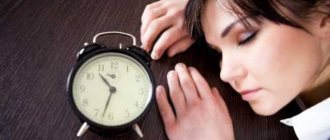Causes of headaches with sudden movements
Pain may occur with sudden bending or turning of the head. This is due to pathologies of blood vessels, nerves, pressure changes and other reasons. Pain can also appear in a healthy person due to intense physical activity, stress and disruption of the sleep schedule. Most often, painful sensations go away after proper rest, but in some patients they indicate serious disorders that require treatment.
Migraine
Migraine is an acute headache that manifests itself without organic pathologies of blood vessels, brain and other organs. Doctors associate it with neurological disorders or vascular weakness. It has also been established that migraine is more often of hereditary origin and occurs simultaneously in several family members. It has a chronic course and manifests itself in the form of attacks, which can be caused by internal or external factors. Thus, migraines often occur against the background of climate change, stress, insomnia, and intense training.
The attack can last up to several days and consists of four phases:
- The prodromal period is a few days before the onset of headache. During this time, many patients experience weakness, dizziness, insomnia, as well as hearing and vision impairment. However, symptoms may be mild and unnoticeable.
- Aura is a neurological disorder that occurs immediately before or during the onset of a headache. An aura can include visual, auditory and movement (motor) disturbances, as well as combinations thereof. Characteristic symptoms are the appearance of dark circles in the field of vision, tinnitus, nausea and dizziness, and deterioration in coordination of movements. About 50% of migraine cases occur with aura; in other patients it is absent. (see Migraine with aura).
- The pain phase lasts no more than a few hours in children and 1–3 days in adults. The pain is sharp, severe, often spreading to the temples and the side of the head. It intensifies with any physical activity and sudden movements of the neck. During this phase, nausea and dizziness, weakness, and impaired consciousness and concentration may also be felt.
- Postdromal period - occurs when the headache goes away. A few days after the attack, you may feel worse. Patients experience weakness, gastrointestinal disorders, mood swings and other symptoms that disappear within 1–2 days, depending on the intensity of the attack.
Migraine often affects only half of the head, but can spread to its entire surface. The headaches are severe and worsen when turning and tilting the head, as well as with any sudden movements of the neck. Mild attacks can be relieved with painkillers, but for acute pain, the doctor will prescribe special medications against migraines.
Read more in the material: Chronic migraine
Hypertension
The blood pressure of a healthy person at rest is 120/80 mm. rt. Art. It is easy to measure at home using a tonometer. If the result is 130/90 mm. rt. Art. and more, we can talk about hypertension (high blood pressure). It is important that hypertension is physiological - blood pressure normally increases after exercise. To obtain accurate data, they were shown filming during rest.
Hypertension is a chronic disease that is manifested by increased blood pressure. It is most often diagnosed in middle and old age, but can also occur in young adults and children. Its causes are congenital disorders of pressure regulation mechanisms and acquired vascular diseases. During an attack, blood pressure increases sharply, which is accompanied by the following symptoms:
- throbbing headache, which intensifies when tilting and turning the head - it can spread to the temples, back of the head, frontal part;
- deterioration of vision, hearing, concentration;
- numbness of fingers and toes;
- swelling, redness of the skin of the face and mucous membranes;
- the appearance of small subcutaneous hematomas, especially in the face;
- arrhythmia, uneven and rapid pulse.
People who are overweight and those who lead a sedentary lifestyle are at risk. To treat hypertension, your doctor will select a special diet and prescribe medications to correct your blood pressure. They must be taken in a course to prevent another exacerbation.
Read more in the material: Headache with hypertension
Diseases of the cervical spine
The cervical region contains important vessels and nerves that lead to the brain. They are located in the protective canal formed by the openings between the vertebrae and on their lateral processes. In a healthy person, between the bone segments there are intervertebral discs - dense, elastic cartilaginous formations that absorb shock during movement. Their damage can be caused by various diseases, but leads to acute pain and affects general well-being.
- Cervical osteochondrosis is a chronic process of destruction of intervertebral discs. It can be caused by intense exercise, a sedentary lifestyle, or a disruption in the flow of blood to the cartilage. It leads to compression of the nerve roots and acute headaches, which intensify with neck movements. (see Headache with osteochondrosis of the cervical spine)
- Protrusion is a protrusion of cartilage beyond the spinal column. The process is accompanied by headaches and decreased neck mobility. In advanced cases, a hernia forms - the outer fibrous membrane ruptures, and the liquid contents (nucleus pulposus) leak out.
- Spinal curvature can be congenital or acquired. The process is often caused by incorrect posture and intense stress during the period of growth and formation of the spinal column.
To treat diseases of the cervical spine, the doctor will prescribe a comprehensive treatment regimen. It may include exercises to strengthen the neck muscles, massage and physiotherapy, as well as a course of medications. Painkillers and anti-inflammatory drugs, muscle relaxants, and warming ointments help with these diseases.
Vascular diseases
Atherosclerosis is one of the reasons why headaches occur during sudden movements. This is a chronic disease in which lipoproteins and cholesterol are deposited on the inner walls of the arteries. These deposits can form plaques, cause narrowing of the lumen of blood vessels and reduce the elasticity of their walls. This leads to a deterioration in blood flow to the brain and painful sensations. At the first signs of atherosclerosis, it is important to follow a low-fat diet, as well as take medications to remove excess cholesterol.
Read more in the material: Constriction of cerebral vessels
Diseases of the ENT organs
Headaches with sudden movements can also be caused by inflammation of the ears, mucous membrane of the nasopharynx or respiratory tract. Colds occur when a viral infection occurs and the body's immune defense is simultaneously reduced. It is important to get tested if the following symptoms worsen:
- fever for 3 days or more;
- the appearance of discharge from the nose or ear canals;
- weakness, headache;
- pain in the head area.
A characteristic symptom of sinusitis is a sharp headache when tilting the head down. If it is confirmed, the doctor will prescribe an additional x-ray examination. Treatment for most diseases of the ENT organs includes antibiotic therapy, lavage of the nasal passages, the use of ear drops and vasoconstrictors.
Other reasons
Headaches often appear due to stress, nervous tension, changes in atmospheric pressure and disturbances in sleep schedule. However, if they occur frequently, including after exercise, it is important to get tested. These symptoms may indicate the following disorders:
- brain tumors;
- neuritis - inflammation of the nerves that run in the neck and head;
- poisoning – associated with the intake of poisons and toxins from food, medicines, gaseous substances;
- stroke is one of the dangerous conditions that occurs when there is a sudden disruption of blood circulation in the brain; (See stroke)
- temporal arteritis is a specific disease in which inflammation of the temporal artery occurs;
- cluster pain is a rare type that is very severe. (see Cluster headaches)
Headaches are not a separate disease, but a symptom characteristic of many disorders.
Doctors do not recommend enduring painful sensations. As first aid, you can take a pain reliever, but then it is important to undergo a full examination.
Why does it hurt to tilt your head
The most common cause of this condition is overstrain of the neck muscles.
To do this, it is not necessary to carry weights, just stay in an uncomfortable position for a long time. Dozens of muscles belonging to the muscles of both the cervical region and the body are attached to the cervical vertebrae. They are divided into flexors and extensors and internal and external rotators. They are responsible for the fact that the neck hurts and it hurts to lower your head down, tilt it back or to the side.
These muscles act in pairs: when the flexor or internal rotator is tense, the extensor or external rotator is relaxed, and vice versa. Prolonged tension leads to the fact that the muscle is poorly supplied with oxygen and a spasm occurs. The muscle cannot relax; the blood flow in it must first be restored. Trying to force a spasmed muscle to work causes severe pain.
Many diseases can lead to similar symptoms. For example, the following diseases of the spine and surrounding tissues:
- osteochondrosis - dystrophy of spinal tissue, starting with the intervertebral disc and then spreading to surrounding tissues;
- spondylosis - the appearance of osteophytes (dense areas of tissue where they should not be);
- radiculitis - damage to the roots of the spinal nerves;
- myositis - inflammation of the neck muscles;
- osteoporosis - decreased density and increased fragility of bones, sometimes leading to spontaneous fractures, including cervical vertebrae;
- spinal canal stenosis - narrowing of the canal due to the growth of the surrounding cartilage and soft tissue;
- intervertebral hernia - rupture of the fibrous ring of the disc and protrusion of its nucleus, causing pain of a different nature or even paresis, depending on where exactly the rupture occurred;
- neoplasms (tumors) compressing nerve roots.
These are the most common diseases, due to which, when your neck hurts, it hurts to tilt your head forward, backward or to the side. The next reason is injuries. As a rule, the patient can accurately name the event that caused the pain. Most often, the neck is injured by sudden movements. As a result, the head tilts sharply towards the force acting on the person, and then, by inertia, leans back in the opposite direction. This is a whiplash injury. Its most likely result is a strain or, less commonly, a tear in the muscles or tendons involved in the movement.
A fracture or displacement of the vertebrae can also cause pain when changing the position of the head. Therefore, if severe pain occurs as a result of an injury or 2-3 days after it, you must definitely go to the emergency room.
Among diseases not associated with the cervical spine, characteristic symptoms can occur with migraine (like the head, the neck in this disease also bothers more often on one side), hypertension, sinusitis and sinusitis, inflammation of various nerves and nerve plexuses.
Diagnostic methods
At home, it is impossible to determine exactly why a headache occurs. This information is necessary to choose an effective treatment that will affect not only the symptoms, but also their cause. The doctor will prescribe a set of examinations, which may include:
- X-ray of the cervical spine is the easiest way to diagnose osteochondrosis and other neck diseases;
- Dopplerography - ultrasound of the vessels of the neck and head using a contrast agent;
- MRI, CT – examinations that will allow you to accurately visualize intervertebral protrusions and hernias, neoplasms and hematomas of the brain, the consequences of a stroke;
- Blood tests will show inflammatory processes and metabolic disorders.
The Clinical Brain Institute offers individual headache diagnostic programs. The main advantages of our center are precise modern equipment and comfortable conditions for a hospital stay during the period of examination and treatment. Learn more about our programs.
What may accompany neck pain
Pain in the neck when tilting the head forward, to the right, to the left or back is a symptom in itself, but sometimes it is accompanied by sensations that will help the doctor more accurately establish a preliminary diagnosis.
If your neck hurts when you tilt your head back, forward, left or right, and there is pain and numbness in the arm on the affected side, this indicates radicular syndrome or conditions associated with damage to the intervertebral discs. If it “shoots” in different parts of the body, and the pain is not relieved by prescribed medications, most often this is how inflammation of the nerves and neuritis manifests itself.
If the neck hurts when turning and bending, and the patient experiences dizziness, nausea, pain in the back of the head, there are likely problems with the spinal canal, vertebral displacement or subluxation, or intervertebral hernia.
An increase in body temperature that accompanies the main symptom may indicate myositis - severe inflammation of the muscle. If it is accompanied by vomiting, confusion, severe headaches, emergency help is needed: this may indicate inflammation not of soft tissues, but of the brain or spinal cord.
Treatment of headaches
The treatment regimen will include steps to relieve symptoms and eliminate the causes of the headache. It is prescribed only after an examination, when it becomes known why pain and discomfort occur with sudden movements. It may include the following methods:
- drug treatment - includes taking antibiotics, muscle relaxants, painkillers and anti-inflammatory drugs;
- therapeutic exercises – at home it is useful to perform exercises to strengthen and relax the neck muscles;
- physiotherapy - targeted effects of a magnetic field, electric current, heat on painful areas;
- massage - the procedure must be performed by a specialist.
Doctors at the Clinical Brain Institute warn that self-medication can lead to dangerous consequences and the gradual development of chronic diseases. The effectiveness of the prescribed regimen depends not only on taking medications, but also on the implementation of other prescriptions: a therapeutic diet, exercises at home and other procedures.
How to cure without harming
The standard of treatment for neck pain is the same as for other areas of the spine. These are non-steroidal anti-inflammatory drugs, with the help of which pain is reduced and inflammation is partially stopped, and physiotherapy, aimed at improving blood circulation in the diseased area or delivering medications to it. B vitamins are often added to the course, as well as medications that relax muscles. In most cases, this set of medications is enough to relieve pain.
The abundance of causes of cervicalgia, including those associated with head movements, means that standard therapy does not always help. Therefore, self-medication or treatment without examination is unacceptable. At the first appointment, the doctor may prescribe medications to alleviate the patient’s condition, but diagnostic procedures must also be recommended along with them.
If it turns out that the cause can be eliminated completely, then the treatment is changed. But it happens that the cause is a chronic disease, or it cannot be determined at all during examinations. In such cases, manual therapy can help.
It is impossible to resort to manual therapy before a full examination of the condition of the spine. This method of treatment involves serious impact on muscles and joints, and in some situations can be harmful.
Prevention methods
Headaches are rarely a consequence of congenital pathologies; more often they arise as a result of acquired diseases. They can be prevented if you follow simple recommendations from doctors:
- monitor your posture throughout the day and while working at the monitor;
- do gymnastics for your back and neck every day;
- choose proper nutrition, give up fatty foods and fast food;
- get rid of bad habits.
Headaches are a dangerous symptom that may indicate dangerous diseases. At the Clinical Brain Institute, you can undergo a comprehensive diagnosis and determine what is causing it. Experienced doctors will select an individual treatment regimen to not only get rid of pain, but also stop the further development of diseases.
Clinical Brain Institute Rating: 3/5 — 2 votes
Share article on social networks










